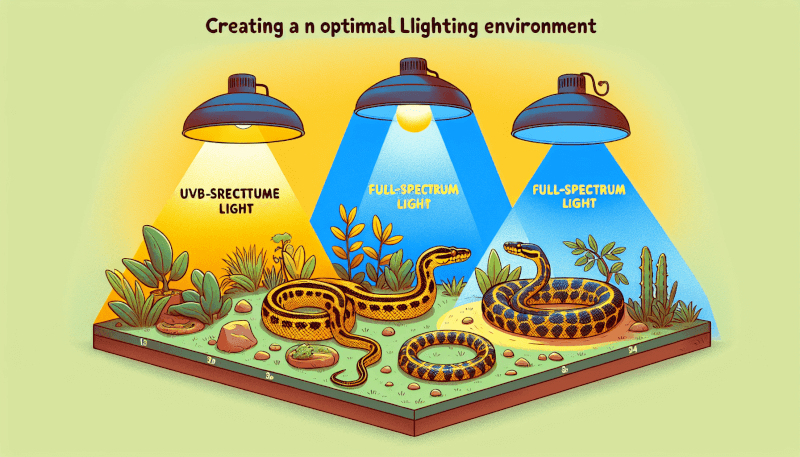Are you a proud snake owner? Ensuring the well-being of your slithering friend is of utmost importance, and this includes providing them with the right lighting in their habitat. In this article, we will explore safe and natural lighting options that are specifically tailored to cater to the needs of your snake. From understanding the importance of lighting for their health and well-being to exploring different types of lights and their benefits, you will discover all the essential information you need to create a comfortable and thriving environment for your scaly companion. Say goodbye to guesswork and hello to a well-lit and contented snake habitat!

Importance of Proper Lighting for Snakes
Understanding the role of lighting in a snake’s habitat
Proper lighting plays a crucial role in the overall health and well-being of your pet snake. Lighting not only provides the necessary visibility for you to observe your snake’s behavior and monitor its health, but it also helps create an environment that closely resembles its natural habitat. Snakes are ectothermic, which means they rely on their environment to regulate their body temperature. By providing appropriate lighting, you can help simulate the natural conditions that snakes require to thrive.
How lighting affects the snake’s behavior and health
Lighting has a direct impact on a snake’s behavior and health. Snakes are crepuscular or nocturnal animals, meaning they are most active during dawn and dusk. By providing proper lighting, you can establish a natural day-night cycle in their habitat, which helps regulate their activity levels. Additionally, appropriate lighting provides essential cues for feeding, shedding, and breeding. Insufficient lighting can disrupt these natural behaviors and negatively affect your snake’s health.
Choosing the Right Light Bulbs
Considerations for selecting safe and natural light bulbs
When choosing light bulbs for your snake’s habitat, it is crucial to select ones that are safe and provide a natural spectrum of light. Avoid using incandescent bulbs, as they produce excessive heat and can lead to burns or discomfort for your snake. Opt for bulbs specifically designed for reptiles, which emit the appropriate wavelengths of light without generating excessive heat.
Types of light bulbs suitable for snake habitats
There are several types of light bulbs suitable for snake habitats. Full spectrum daylight bulbs mimic natural sunlight and provide a balanced spectrum of visible light. These bulbs not only enhance the aesthetics of the habitat but also contribute to your snake’s overall well-being. Alternatively, fluorescent bulbs, such as compact fluorescent bulbs, are energy-efficient and emit minimal heat, making them ideal for providing ambient lighting in your snake’s enclosure.
UVB Lighting for Vitamin D Synthesis
The importance of UVB lighting for snakes’ health
UVB lighting is crucial for snakes as it plays a vital role in their health. Snakes rely on UVB radiation to synthesize vitamin D3, which is essential for the absorption and metabolism of calcium. Without adequate vitamin D3, snakes are at a higher risk of developing metabolic bone disease, a condition characterized by weakened bones and skeletal deformities. UVB lighting also promotes natural behaviors, such as basking and thermoregulation, by simulating the sun’s rays in their natural habitat.
Choosing the right UVB bulbs for different snake species
Different snake species have varying UVB requirements, so it is essential to select the right UVB bulbs accordingly. Research the specific UVB needs of your snake species and choose bulbs that emit UVB radiation within the appropriate range. It is crucial to monitor the distance between the UVB bulb and your snake’s basking spot to ensure they receive the optimal amount of UVB exposure without the risk of overheating.
Providing Daytime Lighting
Creating a natural day-night cycle in the habitat
To mimic the natural environment of your snake, it is important to establish a proper day-night cycle in their habitat. During the daytime, provide lighting that closely resembles natural sunlight. This helps regulate your snake’s circadian rhythm, allowing them to engage in their natural behaviors at appropriate times. The presence of proper daytime lighting also aids in their digestion and overall activity levels.
Recommended light intensity and duration during the day
The recommended light intensity for your snake’s daytime lighting should be bright but not excessively intense. Aim for a light intensity of around 5,000 to 7,000 Kelvin to replicate the natural daylight spectrum. As for the duration, provide approximately 10-12 hours of light per day. This allows your snake to have an adequate period of rest during the night, promoting a healthy sleep-wake cycle.

Simulating Moonlight for Nighttime
Why snakes need simulated moonlight
Snakes are predominantly crepuscular or nocturnal animals, meaning they are most active during dusk and night. Simulating moonlight in their habitat provides them with a sense of security and helps regulate their natural behaviors. Moonlight also aids in maintaining their circadian rhythm, influencing their sleep patterns and activity levels. By incorporating simulated moonlight, you can create a more natural and comfortable environment for your snake during nighttime hours.
How to create a moonlight effect in the habitat
To create a moonlight effect in your snake’s habitat, you can utilize specialized moonlight bulbs or LED lights designed to emit a cool blue spectrum. These bulbs emit a softer and dimmer light, replicating the gentle glow of the moon. It is important to ensure that the moonlight is not too bright, as excessive light during the night can disrupt your snake’s natural behavior and potentially interfere with their sleep cycle.
Adjustable Lighting Dimmers and Timers
Benefits of using dimmers and timers in snake habitats
Using adjustable lighting dimmers and timers in your snake’s habitat offers several benefits. Dimmers allow you to control the intensity of the lighting, ensuring that it matches the specific needs of your snake species. This is particularly useful when creating a daytime and nighttime lighting schedule. Timers, on the other hand, automate the lighting cycle, providing consistent and reliable lighting for your snake. These features not only make it easier for you to maintain an appropriate lighting schedule but also contribute to your snake’s overall well-being.
Recommended settings for adjusting light intensity and duration
The recommended settings for adjusting light intensity and duration may vary depending on the specific requirements of your snake species. It is important to consult reputable sources or seek advice from a veterinarian or experienced reptile keeper to determine the optimal settings. Generally, aim for a gradual dimming of the lights during the evening to simulate the transition from daytime to nighttime. Ensure that the nighttime lighting is not completely absent, as some snake species benefit from a low level of ambient light during the night.

Flicker-Free Lighting for Snake Comfort
Understanding the negative effects of flickering lights on snakes
Flickering lights can have detrimental effects on snakes’ well-being. Snakes have highly developed visual systems and are sensitive to rapid changes in light. Flickering lights can cause stress, anxiety, and disorientation in snakes, as it disrupts their visual perception. Prolonged exposure to flickering lights can lead to behavioral issues, decreased appetite, and overall decline in health. It is crucial to choose lighting sources that provide a stable, flicker-free illumination to ensure your snake’s comfort and well-being.
Choosing flicker-free light sources
To provide your snake with a comfortable and stress-free environment, opt for light sources that are specifically designed to be flicker-free. LED lights are an excellent choice as they emit a steady and consistent light without any noticeable flickering. Additionally, fluorescent bulbs, particularly those marketed for reptile habitats, are another reliable option. Investing in high-quality, flicker-free light sources will contribute to maintaining a healthy and content snake.
Energy-Efficient Lighting Options
Exploring energy-efficient lighting solutions for snake habitats
Energy-efficient lighting not only benefits the environment but also offers practical advantages for snake owners. LED lights are an energy-efficient choice for snake habitats as they consume less electricity and have a longer lifespan compared to traditional incandescent bulbs. Additionally, LED lights emit minimal heat, reducing the risk of overheating in your snake’s enclosure. This energy-efficient lighting solution allows you to provide optimal lighting while keeping your energy consumption and costs down.
Comparing the pros and cons of different energy-efficient bulbs
When considering energy-efficient lighting options for your snake’s habitat, it is essential to weigh the pros and cons of different bulbs. LED lights have numerous advantages, such as energy efficiency, long lifespan, and low heat emission. However, they can be more expensive upfront compared to other options. Compact fluorescent bulbs, on the other hand, are affordable and energy-efficient but may not last as long as LEDs. Consider your specific needs and budget when choosing the most suitable energy-efficient lighting solution for your snake’s habitat.

Avoiding Overexposure to Artificial Light
The risks of excessive artificial lighting to snakes
While providing appropriate lighting is crucial, it is equally important to avoid overexposing your snake to artificial light. Excessive exposure to artificial light can disrupt your snake’s natural sleep-wake cycle and lead to stress and health issues. Snakes require a period of darkness to rest and recover, just like they would in their natural habitat. Therefore, it is crucial to establish a proper light-dark cycle to promote your snake’s wellness and prevent any adverse effects of prolonged artificial lighting.
Implementing proper light-dark cycles for snake wellness
To ensure your snake’s wellness, it is recommended to establish a proper light-dark cycle that mimics its natural environment. During the day, provide bright lighting that resembles natural sunlight. As evening approaches, gradually reduce the light intensity to simulate dusk. Finally, provide a period of complete darkness during the night to allow your snake to rest and recharge. Maintaining a consistent light-dark cycle helps regulate your snake’s internal clock, promoting healthy behaviors and overall well-being.
Maintenance and Replacement of Light Bulbs
Tips for maintaining the lifespan of light bulbs
To maximize the lifespan of your snake’s light bulbs, it is important to follow certain maintenance tips. Regularly clean your light fixtures and remove any dust or debris that may accumulate. Overheating can shorten the lifespan of bulbs, so ensure proper ventilation to dissipate excess heat. Additionally, avoid frequently turning bulbs on and off, as this can decrease their longevity. By maintaining clean and well-ventilated light fixtures, you can extend the lifespan of your snake’s light bulbs and minimize the need for frequent replacements.
When and how to replace light bulbs in the snake’s habitat
Light bulbs in your snake’s habitat may need replacement periodically to ensure optimal lighting conditions. Regularly inspect your bulbs for signs of dimming, discoloration, or flickering, as these indicate that a replacement is necessary. It is advisable to have spare bulbs readily available to quickly replace any faulty or expired bulbs. When replacing bulbs, follow the manufacturer’s instructions and be cautious to avoid breakages or accidents. Regularly monitor the condition of your snake’s light bulbs to ensure they provide the necessary lighting for your snake’s health and well-being.



